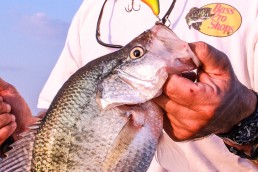3 Crankbait Tactics for Summer Crappies
SHARE THIS POST
Here are three tactics Tim Huffman employs to catch summer crappies on crankbaits.
Crankbaits catch crappies. They are extremely good for targeting open water fish that won’t be caught using slow presentations, because the fish are too scattered and not relating to cover. But, three specific crankbait tactics have proven extra successful for catching open water crappies.
Longline trolling
Longlining is pulling baits behind the boat. Guide Brad Chappell is an expert longline troller who often pulls plastics, but will switch to crankbaits when fish are aggressive. He says a fisherman’s primary job is to find the right speed, depth and color. That sounds easy, but those are three variables often difficult to put together.
“Trolling motors with automatic steering make everything much easier now, so one fisherman can longline without the fear of the boat spinning,” he says. “I can stay in the back of the boat while the trolling motor takes care of keeping a straight course. I can make adjustments from the back of the boat with a remote.”
Chappell prefers Bandit 300 series crankbaits. He will pull them along creek ledges, flats and other spots where crappies feed on shad. Line lengths will often range from 50 to 140 feet, but they can be shorter or longer if needed.
“Side imaging electronics are a big plus,” says Chappell, “because I can see out the side of the boat to find schools of shad and crappies. The baitfish are often the key to finding crappies.”
Longline trolling can be done off the back of the boat or by using poles off the side. Having poles of different lengths is important to give line separation between baits. A good setup might include 16-, 12- and 8-foot long poles.
Pushing
Pushing is a method where long, stiff 16-foot poles are used to push baits ahead of the boat. It’s a great method for putting baits in more precise spots than possible in longlining or using planer boards. Ledges can be followed and turns are much easier and faster.
Eight-time national champs, Ronnie Capps and Steve Coleman, prefer to push baits instead of pull them. Their setup includes heavy line, a 4-ounce sinker and 200-series Bandit crankbaits.
Are you enjoying this post?
You can be among the first to get the latest info on where to go, what to use and how to use it!
Capps says, “We use a heavy line, 20- or 25-pound test, so baits can be ripped from cover when we do hang up. The heavy 4-ounce sinker keeps the bait down even at fast trolling speeds. We cover a wide path and we don’t let cover scare us away.
Further, he says, “We want boat control, and pushing gives that to us. We can make sharp turns without worrying about longlines out the back. We can put baits exactly where we want them.”
The team also encourages caution with the crankbaits. “Having a long pole, heavy lead weight, treble hooks and a flopping fish can be very dangerous. A white bass, striper or catfish can be the worst because of speed and size. It’s fun for us, catches a lot of fish, but can be dangerous, so be careful.”
Planer boards
The easiest way to learn to pull planers is to go with someone willing to teach you. Show-and-tell is better than learning on your own, but magazine articles and YouTube videos can help.
Like other methods, the auto trolling motors are critical. If the boat turns while you’re catching a fish, you suddenly have a tangled mess that will ruin your day. The problem can happen quickly on a windy day.
Equipment should include strong poles because planer boards apply a lot of extra pressure. Line-counter reels are important for setting bait depth and length-of-line to the planer board. Bandits, Flicker Shads and many other crankbaits can be productive. The key factor is for a crankbait to have proper action at trolling speeds from 1.3 to 2.4 miles per hour.
Fishing with planer boards is a little more work than pulling straight behind the boat. However, on days when the fish are a little spooky, the boards can produce many more fish. Get in on the summer fun.
Summer is great crappie fishing time! Read more about crappie fishing in the August issue of MidWest Outdoors, available now at the newsstand or by subscribing on our website.
MWO
SHARE THIS POST
You may also like...
Nothing found.
Did you enjoy this post?
You can be among the first to get the latest info on where to go, what to use and how to use it!
Tim Huffman
Tim Huffman specializes in crappie fishing, is editor for two crappie magazines, as well as writing for several others. In 2018, he published his sixth book, Limiting Out for Crappie, available at Amazon. His first article appeared in MidWest Outdoors in 1988.
